

Rioting - Who finds it Exciting and Enjoyable?
by Pat Dade, 15th August 2011
Background
This short paper examines the riots in England on August 7th to 10th 2011. Journalist Zoe Williams of the Guardian was the first to dub these disturbances "shopping riots", a nomenclature with which we concur. They were the first 'consumer' riots.
Apart from the extreme youth of many of the participants, commentators and analysts have struggled without success to find a ‘demographic’ base for the majority of participants. Values analysis provides insights not available through other means.
This is not to ignore a range of other factors cited by others - perceived disconnects in class, race, employment and educational structures, for example: nor is this a ‘pop psychology’ attempt at cleverness. This paper is evidence based, focuses on a specific age group and does not attempt to extend its analysis beyond 15 to 24 year olds. Data for older age groups is available in the British Values Survey database.
For over 38 years Cultural Dynamics, and its antecedents, has been measuring and analysing the currents and flows of social change from a psychological and behavioural viewpoint. Our analysis is based on a significant body of British data, and practice with hundreds of public and private organizations, and is part of a worldwide body of data gathered from many sources.
Specifically, using data from our 2008 British Values Survey, we have identified a set of values and beliefs which represent a fertile psychological orientation for ‘anti social behaviour’, particularly among the under 25s, those most in evidence during the riots.
We call this area the Danger Zone.
This analysis uses terms that are known to clients and regular readers, but may be unfamiliar to new readers. Links and footnotes aim to provide background and context.
Our evidence and analysis is presented in a series of steps, beginning with a presentation of values gradients for each of three age groups:
- 15 to 17 year olds
- 18 to 21 year olds
- 22 to 24 year olds
We then outline the inevitability of an outbreak of this kind of behaviour and the values composition of the Danger Zone. An analysis of the Asocial Attribute is particularly illuminating, and includes gradient maps in relation to two highly relevant statements measured in the British Values Survey 2008. A ‘talking points’ conclusion draws the threads together in a preliminary set of feedback questions and statements that can be used to frame further discussion
Tottenham
On Sunday 7th August 2011 we published a short piece about the Tottenham Riot – then a one-off, localised disturbance seemingly brought about by a local issue. The burning and looting made good pictures and media coverage, and with Parliament recessed for the summer the London-dominated media had a ‘good story’.
We noted politicians, pundits and the public would have ready pronouncements on the situation but that most or all would not have the values ‘language’ to understand the behaviour occurring that first night. This observation still stands, but as the scale of the behaviour increased to unexpected proportions and spread outside London the story became bigger and more complex. Now more than ever a better way of understanding this behaviour is needed.
We have been asked by several clients to expand on the evidence we have about Golden Dreamers and, particularly, in the part of the Values Map highlighted as the Danger Zone.
Inevitable surprise
The following is evidence from the British Values Survey 2008 and has been presented to clients over the last several years. Behaviour of this type from a particular values set was to be expected and can be understood. It is a classic example of an "inevitable surprise". Our own data as well as many commentators had predicted something of the kind but the evidence was disregarded.
Often economic, sociological and/or technological research and analysis can yield insights into the basis of the inevitable surprise. In the case of the UK’s first ‘consumer riots’ the form of analysis most useful to social analysts and policy makers comes in the form of psycho-social research – the study of values systems in dynamic social environments.
The Danger Zone defined
In another recent paper we defined the three competing values based orientations – Settler, Prospector and Pioneer - common to all people and societies and the tensions these different orientations can produce in institutions.
Interpretation of the evidence into the dynamics of social change created by these tensions has led us to be very clear about the values that drive many behaviours that are seemingly deviant, but keep repeating in a variety of guises.
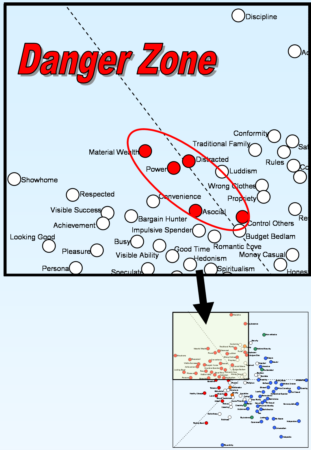 |
As a consequence, we do not define them as deviant, but as a normal part of the process of change in human values systems and their cultures. Values cannot be deviant: they simply are. In this section we explore some of the aspects that made the behaviour seen on English streets inevitable and also place the behaviour in context. We hope this will help inform political and social response. The Danger Zone can be found where human values systems move from Settler to Prospector. The ‘moral’, rules-based Settler environment is no longer sufficient to enable those on the cusp of change to achieve satisfaction. The old rules that provided stability now seem oppressive and stifling. A new world beckons, a Prospector world, one where anything is possible. As bounded and accepted morality frays around the edges new, multiple possibilities for recognition by others and rewards for social displays of prowess emerge and drive an excitement with life not previously experienced. Anything and everything is possible and only the experience of trying new forms of behaviour will enable the person to know what is best for them. No amount of moralizing will stop the person in the Danger Zone from doing or thinking what they want to ‘right now’. This is normal. It is a developmental stage about 60% of British people pass through by the time they are in their mid 30s – but it is still a part of the defining values set for many (but not all) young people in their teens to mid 20s. |
The following maps make clear why those looking for a rioter ‘demographic’ are doomed to disappointment. Not all people in an age group are likely to hold the same values – the maps illustrate the gradients of respondents espousing aspects of values in various areas of the maps. For the purposes of this paper we note that individuals within these age groups are particularly espousing Attributes in the area we have called the Danger Zone – but individuals within the age group will be more or less likely to espouse these Attributes and that espousal is dependent on their overall values set, their Values ModeTM.
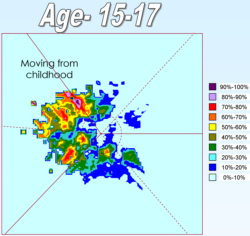 |
 |
 |
To aid in deeper understanding of this variance we explore just one of the Attributes in the Danger Zone as it contains elements that are specifically related to riotous behaviour.
Asocial – defining the Attribute
Asocial is the Attribute that contributes most to an understanding of the propensity for younger people to have been involved in behaviour that has been termed ‘riot’.
Younger people have a greater propensity to be excited or to enjoy and ‘lose themselves in’ behaviour others call ‘anti-social’ than other age groups. To them it is ‘fun’. That said, only a small proportion will be motivated to perform the behaviour, even if given the opportunity and method to do so. The vast majority of people in these age groups will be similar to the rest of the population, and will reject any similarity with ‘the rioters’.
The four statements that correlate and make up the Asocial Attribute are:
- If someone does me a bad turn, I don’t get mad – I get even
- The thought of social disorder excites me
- I look for people’s weak points
- I would enjoy being involved in a street riot
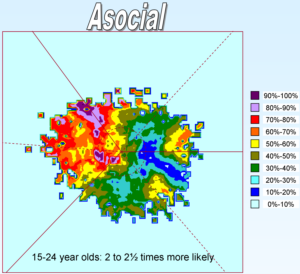 |
Here is the gradient of espousal of Asocial; note the high concentration in the Danger Zone. This is a very disturbing Attribute for most people – in fact, only 17.5% of the British population in total espouse it. The significant factor for those wishing to understand August 2011’s riotous behaviour and its stark age profile evidence is that within the three age groups noted above all are two and half times more likely than the population as whole to agree with the statements. This means these age groups – 15 to 24-year-olds - will contain more than twice the average number of people with a predisposition to become involved in behaviours that normally they wouldn’t do, and who have an orientation to join in if the opportunity arises. Let’s take just two of the espoused statements above and explore them further. |
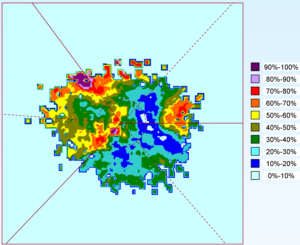 |
“I would enjoy being involved in a street riot.”
Rioting among these age groups is therefore unlikely to ever become a mass behaviour in the UK. This is one key finding of this research. Society is not ‘broken’, or even in danger of being broken, if the sole criterion for brokenness is the August 2011 riots. It is simply that certain values sets have a greater propensity to find such behaviour enjoyable. It is arguable whether the behaviour is enjoyable because it is criminal or whether it is more about gaining the esteem of peers – people in ‘your’ BBM network, say - or being part of a ‘media event’. When the fact of an appearance on reality TV can confer ‘celebrity’ with all its positive associations for these age groups, any media attention can be seductive and sought. |
The media are reporting not only that most of rioters are young, living-at-home schoolchildren, but that many of the working age rioters have jobs. There is no demographic stereotype here that will lend itself to ‘quick and dirty’ analysis. Having a social identity as a criminal is not the driving force in the lives of most people; they are not all gang members. Nor are the August rioters. There are hundreds of thousands of young British people who say they would enjoy a street riot because ‘it is enjoyable’ - it is fun.
This is another key finding of this research.
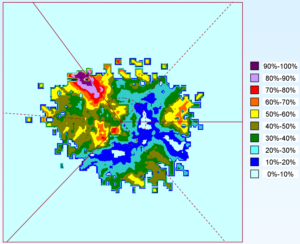 |
“The thought of social disorder excites me.”
In other words, this is not a ‘foreign’ way of thinking for many of them. And as the map shows many of them are congregated in the Danger Zone. This way of thinking enables them to move more easily into a mode of behaviour that is deviant in everyday and media terms – kicking in store windows, running wildly through shops and restaurants and indulging in wholesale looting. In separate research using the British Values Survey but outside the remit of this paper, it has been shown that not only is this age group much more likely to be attracted to ideas and behaviours that present as violent and unacceptable to the majority of the British population but they are also one and a half to two times more likely to fantasize about these sorts of behaviours. As a consequence, when the opportunity to do them occurs, they have already internalized some expected feelings stemming from the behaviour – including having a sense of power over others that they do not experience in everyday life. |
The combination of being excited by the thought of social disorder and having the opportunity to make a fantasy come true is a common factor among people in the Danger Zone. Because the Danger Zone has an over-representation of people in these age groups it is arguable that they are likely to be over-represented in the people on the streets during the August riots.
National newspapers have been particularly good at highlighting the changed opportunities and patterns of behaviour for this age group because of cuts in local youth facilities this summer. For the first time, many of the areas most affected by the riots have seen the closure of, or cutback in, youth clubs and other facilities. Newspaper accounts have printed quotes from youth and social workers noting this situation. With schools no longer warehousing the ‘Danger Zone’ youth the space was filled on their own initiative, in order to make their own ‘fun’.
Preliminary research into our wider database leads us to believe a large factor in the behaviour was that ‘school’s out’ for the summer. Both sides of the left vs. right political divide are arguing about cuts to social and youth services as a driver of behaviour. Maybe another question to be asked is if the behaviour would have happened ‘on a school night’ or if there was homework to be handed in the following day. This is not an idle question. It demands a thoughtful answer if new guidelines are to be drawn up before next year’s Olympics and a chance to ‘really show off’.
Conclusion
Social disorder and civil disobedience – including riot - have occurred for many years and under a variety of conditions – anti war, anti poll tax, student fees, unions protesting government cuts to public services and so forth. All had very different age profiles from the current situation.
In terms of numbers alone, this would indicate that there could be older rioters on the streets if the situation met other criteria for the satisfaction of values driven needs. It is much more likely that riots that are overtly more political or social in origin would attract a higher proportion of over 25s.
Social disorder based on the ‘fun’ of ‘being seen’ and acquiring symbols of value – a consumer riot – is something new and different and demands a different understanding if affected communities and the culture as a whole are to prevent re-occurrences and/or impose appropriate sanctions on the behaviour.
Framing all responses in terms of criminality and responsibility – moralistic language and concepts – is unlikely to prevent further such behaviours by people holding similar values to those who have rioted recently.
As noted in a previous paper the behaviour of young rioters is likely to be driven by pragmatism and not morality or ethics.
The achievement of status among peers is much more relevant to this constituency than the opprobrium of the mass of the UK population or of the police and politicians.
Talking Points
- If rioting is ‘enjoyable’ because it is part of a need to gain the esteem of peers, what kind of activity could replace this behaviour?
- If such behaviour is not ‘normal’ for all 15- to 24-year-olds, what is the likelihood that this behaviour will spread to the wider group?
- Conversely, how can an understanding of non-rioting 15- to 24-year-olds help create opportunities for alternative behaviours that will provide esteem from peers: what alternative calls to action on BBM would produce matching excitement?
- What sanctions can be applied that simultaneously recognize the behaviour as non-productive – not delivering the esteem of others – and provide alternative forms of behaviour that will bring both the esteem of peers and, even more importantly, a form of self esteem not gained in other activities?
This last point is particularly important. Proposed forms of sanctions – prison sentences for minor offences that would receive a judicial slap on the wrist outside the current context – can have the effect of negatively changing self-identities in the formative stage of development typified by Golden Dreamers. Schoolchildren and young working people will now have identities as ‘criminals’ on their official records for the rest of their lives. The record is less important in their individual development than their self-awareness of their record and the ‘criminal’ identity over which they have no control – the very definition of powerlessness, which regular readers will know presents a substantial hindrance to cultural development.
- Could a more positive – and productive – approach be to introduce these young people to restorative justice: to bring them into the community fold and give them the opportunity to gain the esteem of peers (and others) by being involved in the rebuilding of their communities – giving them a stake in the neighbourhood they may feel little connection to at the present time?
Those with responsibilities to their communities through their ‘leadership’ roles, whether formal or informal, need to be creative and not knee-jerk in their analysis of ‘next steps’.
Several of Cultural Dynamics' clients are currently thinking beyond today’s headlines and about tomorrow’s policies and projects. If they and others can creatively develop new forms of interactivity in local areas with little or no budget –initiatives that can harness the energy and drive that drove short term rioting into more positive and long terms forms of changed behaviour - we will all be winners.